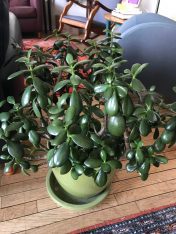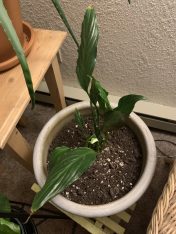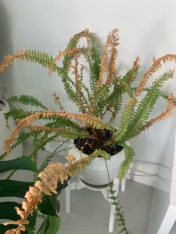Photo illustration by Sebastian Longhitano
Dear Fort Greene Thumb: Our semi-pro expert answers your plant queries
From propagating jade to tips for peace lilies to growing giant indoor avocado trees, our resident plant guy tackles the thorny questions
Well, my beauties, we’ve made it through. The light is shifting, it’s warming up and, like you, my cold dead heart has begun to thaw. Much like the crocuses, daffodils and tulips, we are poking out our tiny heads and reaching towards the sun so that we might get a little light on our faces. This past year has taught us so much about patience. I’ve never waited in more lines in my life. In truth, it’s one of the things I love most about plants. They, too, teach patience and joy in noticing small changes. In the words of the Chinese philosopher Lao Tzu, “Nature doesn’t hurry yet everything is accomplished.”
Earlier this month, I asked you to send me your questions about the care and feeding of your own houseplants. I’ve been inspired by the outpouring of your horticultural inquiries so without further ado, let’s dive in and get our hands dirty. (And if you want to submit a few questions of your own, drop us a line here! Also be sure to check out my favorite Brooklyn plant stores here.)
On to the mail bag!
Dear Fort Greene Thumb,


Thank you!
~ Prue B
This is a very common problem with jade plants or crassula ovata. Given that it seems like your plant is receiving ample light—between four and six hours of direct sunlight is ideal—I would say this is a problem with overwatering. Most succulents and cacti go into a kind of hibernation in the winter months, especially given the lack of light in a Brooklyn apartment. In the winter, It can be wise to slow down your watering schedule and allow the plant to fully dry out between waterings. If you allow your
jade plant to sit in water in the dish, that is no bueno either. You can dump the excess water to prevent another common problem which is root rot but I don’t think thats what’s happening here. Adversely, if your plant is underwatered, it will likely tell you as the leaves will begin to shrivel. I’m not sure what kind of soil it’s in, but it could help to get it in some well draining cacti or succulent soil. This can be a kind of balancing act as we head into these longer, warmer days with more light. Keep an eye on it and in the meantime, if you allow those fallen leaves to dry out for about two weeks, they can be used to propagate new plants to share with your friends. And as this plant is known commonly as the lucky plant, why not spread some of that luck around?
Your frond,
The Fort Greene Thumb


Do you have tips for peace lilies? I can’t seem to find the right balance between over and under watering mine.
Thanks!
~ Sandra
Based on the picture you’ve provided, I can see that your peace lily lives dangerously close to your heater. And aside from my cats, the radiators in my apartment are the other sworn enemy of some of my plants. Peace lilies or spathiphyllum are plants that thrive on the forest floor where they receive dappled light and consistent moisture. They can withstand short dry periods but it will definitely thrive better in an atmosphere with increased humidity. If you can, I would move the plant away from the heater. If not, you just may have to be more diligent about keeping the soil moist. These are also plants that enjoy a good misting. You can invest in a cheap sprayer from your local hardware store. If you want something less utilitarian, you can invest in a bougie-er glass option that looks pretty on a side table but won’t break the bank. If you want to go truly nuts, these plants respond well to sitting on a tray of wet gravel to increase humidity.
The peace lily gets its name from the little white flowers that spring out of the green. The white flowers resemble white flags of peace. And while these plants can tolerate low light, to encourage flowering, you have to increase the light it’s getting. So give peace a chance and get that lily away from the heater and into a sunnier spot if possible.
Your frond,
The Fort Greene Thumb


I have had this fern for over two years now. It was full and resilient even make it through unharmed during a fungus infestation from a neighboring plant when it first moved in. After traveling for the holidays this year and leaving it with a self-watering terra cotta stake, I found many more brown leaves and cut most of them out. I thought maybe it was over-watered and needs a break so I gave it a bit of fertilizer and let it be without water for the last five weeks. The soil is still damp but it’s not showing any sign of recovery. The neighboring plants are so different but seem to be thriving. What can I do to cheer her up?
Thanks for your help!
~ Dahlia
The problem here could be one of two things: Considering that you’ve had this plant for two years without issue, I think it might be time to repot it. Plants like ferns or tracheophyta will sometimes let you know when it’s time to repot it.
Browning leaves can be a sign. If there is a drainage hole on the bottom of your pot, roots will sometimes begin to escape the hole as well. This is another sign that your plant needs to be repotted. Thankfully this time of year is the perfect time to do all of your repotting chores. Gently remove the plant from the pot and massage the roots making sure that you shake off any excess soil. Discard the old soil and place the plant back in the pot firmly with a regular potting soil. The other problem might be overwatering. I know we probably all think that these jungle plants can handle a lot of water, but in a container it is possible to over-water them. It’s possible that the terra cotta stake was maybe too generous while you were away. I find that these kinds of plants also like to be in a room with some running water. So if you have a window in your bathroom or kitchen, perhaps give this plant a little vacation in another room for a while and hopefully you will see those fronds coming back stronger than ever.
Your frond,
The Fort Greene Thumb
Dear Fort Green Thumb,
I have been growing and been successful with avocado seeds. I have one tree that’s about seven feet tall, three others coming up, growing up indoors. I was wondering, can they be outside plants too?
Thanking you for your time.
Always
~ Ellen
You have a seven-foot avocado tree in your apartment?! Color me impressed. So! In 1960 the United States Department of Agriculture began making plant hardiness maps that are broken down into planting zones. The zones are divided based on elevation, proximity to water and extreme winter temperatures. Most times if you buy a tree or shrub at a nursery, the label will let you know which zone the plant is best suited for. In my reading (as I have absolutely no experience with avocado trees), I have found that New York State planting zones range from 3b-7b classification. Most avocado trees thrive best in zone 8. SO CLOSE! That being said, if you do have an outdoor space, It’s possible that the avocado tree could summer outside. Just be sure to ease it into its new environment. Most plants, like me, have trouble with transitions. For instance, I’ve never run and jumped into the ocean before. It takes me about 45 minutes to enter a body of water and by the time I’ve done it, it’s time to go home. Maybe start with giving it a few hours a day outdoors then bringing it back in. This can be tedious, especially with a large tree but I do find that lots of house plants do like to spend a little time outdoors. Rain water is great for getting all that indoor debris off of leaves while you let nature do its thing. And in a few months, if you need a hand, I’ll mask up and come help you move it. I mostly just want to see the thing.
It helps me to think of my houseplants as experiments. It saves me getting discouraged when things go south. There are changes you can make if you look and listen closely to an ailing plant. And if a plant is beyond repair, that doesn’t mean you’re a bad person. It’s okay to bin it and start over.
Your frond,
The Fort Greene Thumb
If you’ve got questions about your plant friends or are having difficulty getting the validation you crave from your plant parents, drop me a line here and I’ll periodically answer a few of your more compelling queries. Just leaf me a note and I’ll do my best to get to the root of your problem: thefortgreenethumb@gmail.com
You might also like 


























